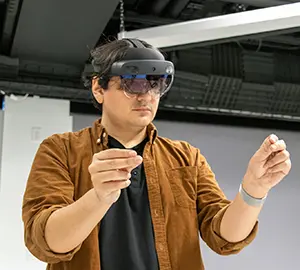Using Augmented Reality to Bring Clarity to Complex Scientific Phenomena
by Tom Hanlon / May 11, 2023

Space is not an easy concept for students—or anyone, for that matter—to understand.
The project that Jina Kang is working on will help students understand not only space, but other complex phenomena in astronomy as well.
Kang, an assistant professor in the College of Education’s Curriculum & Instruction Department, is the principal investigator on a study that is exploring the capabilities of immersive augmented reality (AR) technologies in developing students’ collaborative problem-solving in science contexts.
“Immersive technologies such as virtual reality, augmented reality, and mixed reality are becoming popular in formal and informal educational environments,” says Kang. “The increased adoption of immersive technologies has shown its benefits of enhancing learners’ understanding of abstract or invisible phenomena by allowing for digital representations of phenomena that are not easily comprehensible in the physical world.”
For example, she says, AR headsets allow learners to see holographic images of intangible scientific systems—from micro systems, such as molecules, to macro systems, such as galaxies—in their physical world and use their hands to interact with the objects.
The focus on collaborative problem-solving (CPS) has been identified by the Organisation for Economic Co-operation and Development, an intergovernmental organization with 38 member countries, as a critical competency of the 21st century. “Research has shown that CPS activities in STEM disciplines promote higher levels of motivation, engagement, and achievement,” Kang says. “With AR, people can see each other while they’re working, make eye contact, and talk about things. They can communicate better, learn better, collaborate more efficiently, and that’s one of our goals.”
Developing an AR Learning Platform
Kang’s project is aimed at designing a two-layered AR learning platform—one with learning activities with holographic models of astronomical systems, and a shared workspace that promotes immersive collaborative experiences.
The project began last fall, when she and colleagues designed learning activities using AR technology to teach students about planetary motion. The AR simulation is called “HoloOrbits,” because it projects holographic images into the viewer’s physical world.

“These concepts are invisible and abstract, but through 3D simulations, students can see the planetary motion, and they can manipulate the scientific system by using different types of gestures with their hands,” Kang says. “Our project team, which consists of a computer science undergraduate and PhD students from the College of Education, has worked hard to develop the application despite facing various challenges due to limited resources.”
The project is in a pilot phase now, with Kang bringing in design experts to provide feedback on the simulation’s user experience. Experts in physics and astronomy will also assess the simulation from an educational standpoint. This summer, Kang will invite about 30 non-STEM college students to learn about planetary motion through the simulation. Eventually, she hopes to get this technology into high schools, once the technology drops in price.
“We’re still learning how to design better, how we can maximize the benefits of this new opportunity,” she says. “That’s why we are bringing in these people with different expertise—developers, designers, researchers, subject matter experts, user experience experts, and eventually students. They are all co-designers, giving us their input to improve our design.”
One thing that makes her project unique, Kang adds, is that the students are active in the co-designing process. That’s rarely the case. “Our findings will transform the learners’ voices into the design of a data-driven learning platform,” she says. “And giving students a voice in the design process will not only motivate learning but address their diverse needs, which ultimately facilitates their participation in STEM.”
Exploring Space
Learners will explore an exo-planetary system consisting of a sun and an exo-planet orbiting it, Kang says, noting that they will learn about the motion of celestial objects by applying Kepler’s Laws. “Within the simulation, students have the ability to manipulate the orbital system and observe it from different angles, varying from more flattened to less flattened shapes,” Kang explains. “Our aim with HoloOrbits is to address common misconceptions or beliefs that planetary orbits around the Sun are solely highly elliptical, as they are often represented in 2D images in textbooks.”
The AR simulation can be paused so students can collect data at whatever point they need to, and they will be able to observe how the planet’s speed increases as it gets closer to the sun’s gravitational force and make simple computations to see how what they learned from Kepler’s Laws applies to the exo-planetary system.
Transforming Student Learning
Next year, Kang plans to write papers related to her study and make some conference presentations to share the immersive collaborative problem-solving mapping process, co-design templates, and design prototype with designers and researchers.
“I want to share a toolbox with them for the design of AR learning platforms that deliver collaborative experiences,” she says. “Right now, there is limited knowledge about how immersive technologies can be designed to support the development of CPS competencies. This study particularly bridges the gaps between data, theory, and design for these collaborations to be leveraged in transforming digital traces into meaningful and actionable data-driven insights.”
The end goal, Kang says, is to understand how students interact with the technology and with other students to best support their collaborative efforts and to make better-informed decisions through the data they collect and the collaborations they take part in.
“We want to close the loop from research to design,” she says. “We’re excited about this new opportunity, this new way to transform how students learn by using AR technology.”